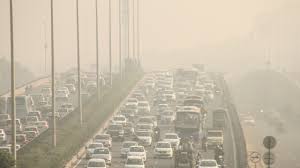The national capital has once again ranked among the top 10 most polluted cities in the world, as the Air Quality Index (AQI) soared past 200 on Monday, October 14, 2025. The reading, classified as “very unhealthy,” has reignited public concern over air pollution and health risks as the winter season approaches.
Smog Blankets the City as Pollution Levels Spike
Real-time monitoring data revealed that concentrations of PM2.5 and PM10 particles in several parts of Delhi — including Anand Vihar, Jahangirpuri, and RK Puram — exceeded safe limits by more than four times. Thick smog reduced visibility across the city, prompting health officials to issue advisories urging residents, especially children, the elderly, and those with respiratory conditions, to stay indoors.
Experts Cite Multiple Pollution Sources
Environmental analysts attribute the spike to a combination of vehicular emissions, construction dust, industrial activity, and stubble burning in neighboring states like Punjab and Haryana. Calm wind conditions and dropping temperatures have also worsened the smog by trapping pollutants close to the surface.
“We are entering the critical pre-winter period when particulate matter tends to accumulate,” said Dr. Meera Krishnan, an environmental scientist. “Without urgent mitigation, air quality could deteriorate further in the coming weeks.”
Authorities Consider Emergency Measures
The Central Pollution Control Board (CPCB) has called on local authorities to enforce stricter dust-control measures, limit construction activities, and improve public transport options to reduce vehicle dependence. The Delhi government is also weighing the activation of the Graded Response Action Plan (GRAP) — a multi-tier system that introduces emergency steps such as restricting industrial operations and diesel vehicle movement during severe pollution phases.
Health Experts Issue Safety Advisories
Public health professionals are urging citizens to take precautionary measures, including wearing N95 masks, using air purifiers indoors, and avoiding outdoor exercise during peak pollution hours. Hospitals have already reported an increase in cases of respiratory irritation and asthma flare-ups as pollution levels climb.
Satellite Data Shows Crop Burning Intensifying
Recent satellite imagery has detected rising smoke plumes from crop residue burning across northern India — a recurring seasonal issue that exacerbates Delhi’s pollution each year. The combination of local emissions and regional agricultural fires typically results in a toxic haze that lingers through late autumn.
Delhi Braces for Another Smog Season
Experts warn that without coordinated national and regional intervention, Delhi could face yet another prolonged smog crisis. Immediate steps in emission control, waste management, and public awareness are essential to avert a public health emergency.
As October unfolds, Delhi’s residents are once again preparing for weeks of hazardous air — a grim reminder of the city’s ongoing struggle to balance urban growth, industrialization, and environmental sustainability.

